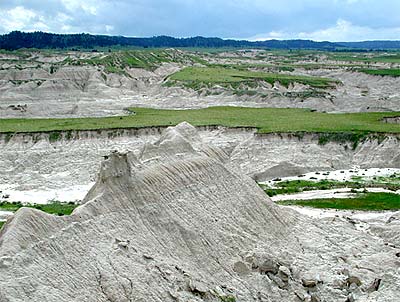 |
 |
 |
 |
 |
|
 |
|
Click on any image to enlarge [above left] Day five of our expedition: We headed north into rural Sioux County, Nebraska, and the Oligocene badlands. Land erosion and subsidence have created a fairy-tale landscape of grass-covered islands, rich in a variety of fossils. Thirty-five to fifty million years ago this area was inhabited by both now-extinct mammals (such as the oreodont), and reptiles, particularly large tortoises [top right] The mud hills of the badlands are covered by a cracked and brittle surface [center right] Fred is quick to descend down into one of the steep-sided gullies — after all, we did have 1,500 acres to cover! [bottom right] The most common finds were fragmented tortoise shells, which weather out of the softer mud. It is unusual to come home with a complete shell, but some fragments were worth collecting, as the fossilization process had colored them lovely shades of yellow, green, and blue. Small, complete shells are among the most prized finds, and a large shell can be more than two feet across and very heavy. At the end of the day, all our acquisitions had to be carried, on our backs, up the nearly vertical canyon sides. As a result, we became quite particular about what we picked up. |